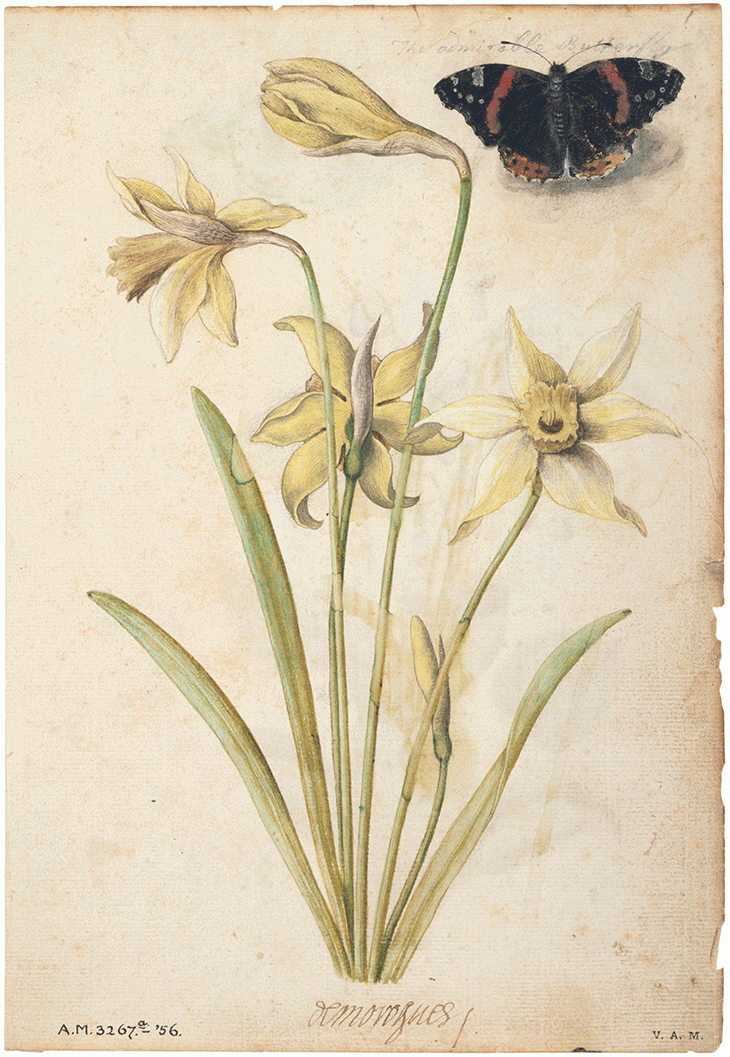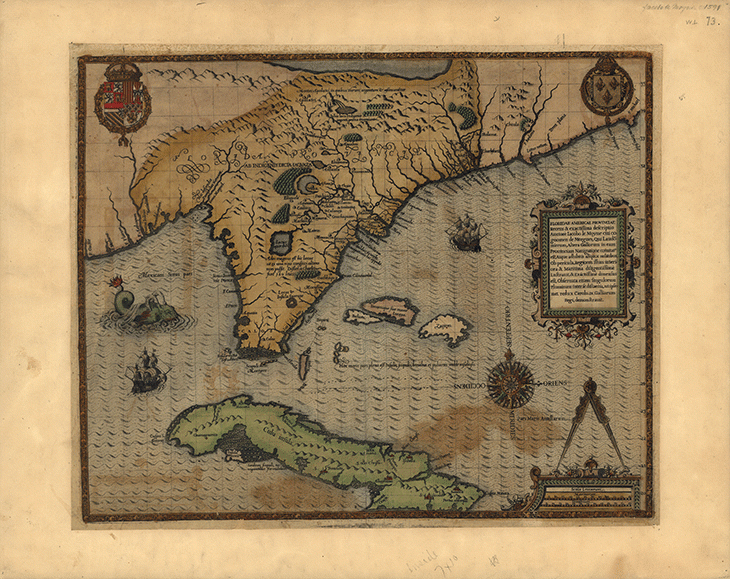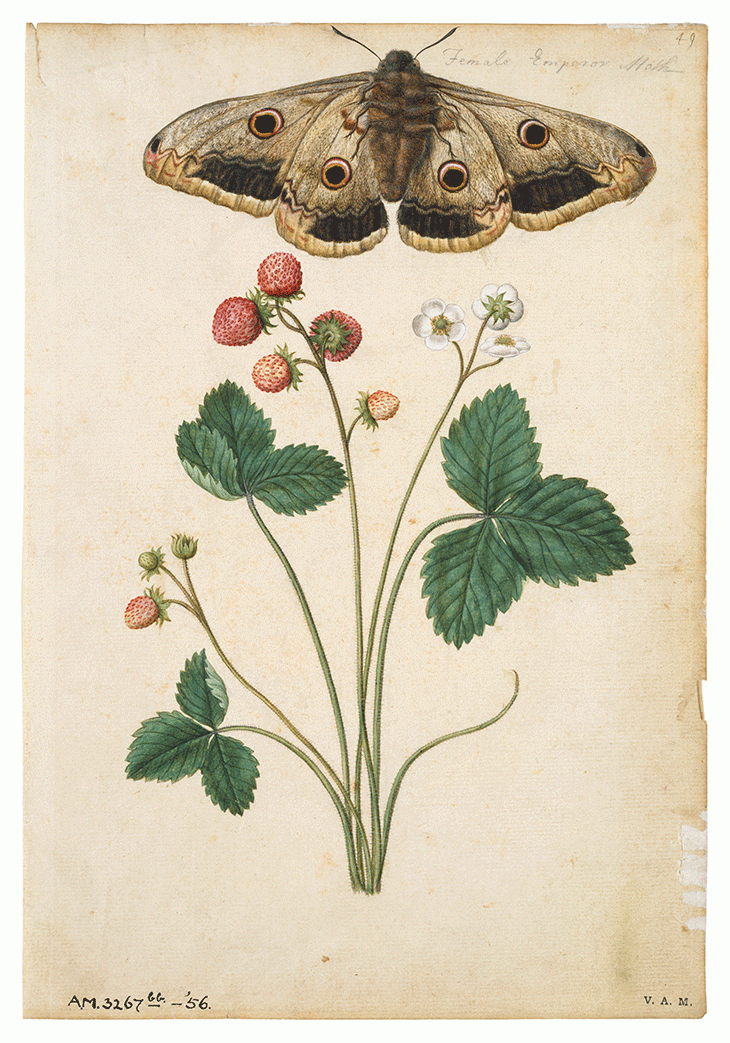The Huguenot artist Jacques Le Moyne was a leading painter of florilegia in the 16th century but his reputation until the 20th century rested on his maps and drawings of a French expedition to Florida in 1564–65. It was not until 1922 that that true worth of the florilegia was rediscovered. Spencer Savage, the Linnean Society’s librarian, recognised as his work an album of watercolour paintings in the collection of the Victoria & Albert Museum. The first painting in the florilegium (‘Daffodils and a Red Admiral Butterfly’) is inscribed at the foot, ‘demorogues’; Jacques Le Moyne had added ‘de Morgues’ to his name after moving to England. Savage identified other paintings by Le Moyne and unravelled the complex history behind the printed versions of his work. Most of them are now in British and American museums, including the British Museum, the Garden Library at Dumbarton Oaks, Oak Spring Garden Library, and the Morgan Library. The albums probably recorded the plants grown in an individual garden (many of the plants are represented in all the florilegia, suggesting a commonality, but each collection has additional plants of its own). They are works of the highest quality, drawn from nature in black chalk, then painted in fine detail in watercolour and body colour.

‘Daffodils and a Red Admiral Butterfly’ (recto) (c. 1575), Jacques le Moyne de Morgues. Victoria and Albert Museum, London
The V&A has digitised the album in its collection as part of its planned display of ‘Renaissance Watercolours’ (twice postponed due to Covid-19; a scaled-back version of the original exhibition is now scheduled to open on 2 December). The images show the paintings as closely as originally intended. In its original order the florilegium of 59 watercolours started with flowers largely grown for their beauty, many with the addition of a butterfly, caterpillar, or moth. Culinary plants follow, largely fruits and nuts, ending with medicinal flowers and herbs. The order may have followed the areas of the owner’s grounds in which the plants were grown; Robert Smythson’s contemporary plans include gardens for flowers, orchards, vineyards, and herb gardens. Looking beyond their function as emblems of beauty, a 16th-century viewer would have recognised the particular symbolism of the different plants.
Le Moyne was born in around 1533 in Dieppe, a town then renowned for its school of mapmakers and the ‘Dieppe maps’ of the world they produced for wealthy patrons – including Henry II of France and Henry VIII of England – to show the latest discoveries and conquests. The school also produced detailed working maps for explorers and mariners for navigation: this may have been the connection for Le Moyne’s recruitment as the cartographer on René de Laudonnière’s expedition to Florida in 1564–65. His brief was to record the coastline and to draw the flora, fauna and the Timucua people. The expedition was a disaster from which most of the crew did not return to France, but Le Moyne survived.

Jacques le Moyne de Morgues’ map of the Florida region (c. 1565), published in 1591 by Theodor de Bry. Library of Congress, Washington, D.C.
The V&A album probably dates from the 1570s, when Le Moyne had started to paint botanical specimens of common indigenous species and around the time he moved to England. Although Dieppe had been a safe haven for Protestants, the Huguenots were persecuted during the Wars of Religion, which began in 1562, and Le Moyne was forced to flee France. He settled in Blackfriars, which like Spitalfields and Soho was an important centre for Protestant refugees from France and the Netherlands. Their community included instrument-makers, apothecaries, physicians, and printers, such as Thomas Vautrollier, who acted as an agent for the Antwerp printer Christopher Plantin and was later to publish Le Moyne’s only printed work, La Clef des Champs, in 1586. Le Moyne’s map of Florida and the drawings of what the explorers found were recognised as of exceptional importance. It was probably as a result of these works that he became acquainted with Sir Walter Raleigh and the artist John White, who was employed to record the English expedition to Virginia in 1585. Laudonniere noted Raleigh’s role as Le Moyne’s patron in his Notable Historie de la Floride (1587), which he dedicated to Raleigh. The illustrations that Raleigh commissioned for it were ‘drawen in coulours […] by the skilfull painter Iames Morgues’. Raleigh may also have paid for Le Moyne’s drawings for Brevis Narratio (1591), engraved and published by Theodor de Bry as part of De Bry’s Grands Voyages (1590–1634).
Fascination with discoveries from the New World did not eclipse the study of indigenous European plants. Herbals produced in the 16th century were intended for scholars as well as wealthy patrons and recorded the plants’ ‘virtues’ – their culinary, medicinal or other properties. Florilegia, however, focused on the aesthetic qualities and although the images were often scientifically accurate, there was little or no text. Le Moyne’s prodigious talent as a painter of such images was acknowledged and his patrons included courtiers of Elizabeth I, herself described by the poet Sir John Davies as the ‘EYE of the Garden, Queene of flowres’. The dedicatee of the V&A album is not known but one of Le Moyne’s other florilegia is dedicated to ‘Lady Mary Sidney’ – either the courtier Lady Mary Sidney (née Dudley) or her daughter, the poet and literary patron Mary Herbert, Countess of Pembroke. Another of his dedications makes clear that the florilegium served to capture the flowers and fruit in perfection – ‘here sweet Flora remains in her beauty’. The images were also used as templates for embroidery or needlework depicting plants or insects. As John Gerard wrote in the introduction to his Herbal (1597), ‘what greater delight is there than to behold the earth apparelled with plants, as with a robe of embroidered work’? A set of octagonal embroidered panels made by Bess of Hardwick, Mary, Queen of Scots, and their gentlewomen in the 1570s show flowers and plants, many of which are ferns, derived from the herbal of the Italian doctor and naturalist Pietro Andrea Mattioli.

‘Strawberry and Female Emperor Moth’ (recto) (c. 1575), Jacques Le Moyne de Morgues. Victorian and Albert Museum, London
The express purpose for La Clef des Champs (also dedicated to ‘Madame de Sidney’) was to ‘serve those to prepare themselves for the arts of painting or engraving, those to be goldsmiths or sculptors, and others for embroidery, tapestry and also for all kinds of needlework’. The woodcuts of plants, animals and birds were simplified versions of the watercolour paintings. The book, printed by Vautrollier for ‘Jaques le Moyne, dit de Morgues paintre’, had labels in French, German, Latin and English. Only three known copies survive, one of which belonged to the naturalist Joseph Banks. Le Moyne died in 1588 but a collection of botanical prints known as the Altera Pars, largely modelled on his watercolours, was produced after his death. The volume was usually sold as an appendix to Crispijn van de Passe’s celebrated florilegium Hortus Floridus (1614). This was produced in collaboration with the bookseller and print publisher Hans Woutneel, who was also an emigré living in Blackfriars at the same time as Le Moyne. Although the Altera Pars was made on the Continent it was intended for an English market and became a primary source for botanical images.
When it eventually opens, the display at the V&A will allow Le Moyne’s work to be seen in the context of other Renaissance watercolours, including the botanical illustrations of Vincenso Leonardi. The colloquial meaning of La Clef de Champs – to escape from constraints – is appropriate to such images, serving to conjure a perpetual primavera during this winter in lockdown.
‘Renaissance Watercolours’ is at the Victoria and Albert Museum, London, from 2 December–April 2021.














![Masterpiece [Re]discovery 2022. Photo: Ben Fisher Photography, courtesy of Masterpiece London](http://zephr.apollo-magazine.com/wp-content/uploads/2022/07/MPL2022_4263.jpg)
‘Like landscape, his objects seem to breathe’: Gordon Baldwin (1932–2025)